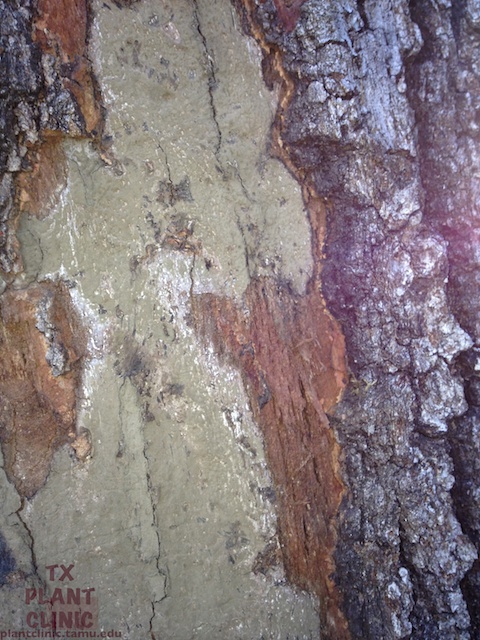Howdy folks! It the time of the year that trees are starting to bud and live oak leaves are starting to drop. So let’s talk about trees.
First, if you see your oak tree that stayed green through the winter turning yellow and dropping leaves – DO NOT PANIC! Check out the tree carefully. Chances are that it is a Texas live oak, and dropping leaves in late winter/early spring is NORMAL as new leaves are coming in shortly. Here is a link to a factsheet that I put together back in 2008.

Photo 1: fungal mat on dying tree
On to more tree stuff. I have been seeing an increase in the questions (email, phone and sample submissions) on dead or dying trees. This include all kinds of trees. Mostly the subject in question are “established” trees. One common statement that I hear is ” the bark is flaking or appears to be popping off”. And usually it is accompanied by a photo or a sample looking like the one in Photo 1. That olive drab or gray or dark brown fungal mat is probably Hypoxylon [ Did you know… What we typically call Hypoxylon canker is actually caused by the fungus Biscogniauxia sp. (Bis-cog-knee-O-sha)] This fungus is what I would consider ubiquitous in the South. There is probably some growing on healthy trees. In healthy trees, the growth of the fungus is kept in check by the natural defenses of the tree. In stressed trees, the fungus can have explosive growth in the absence or reduced tree defenses.
So what will happen to the tree if you see the fungal mat (also known as stroma)? Will it continue to live or is it a mark of death? All good questions, but never good answers. It is possible for tree to “limp” along for a few years, and it is also possible that the damage done is severe enough to cause the tree to collapse quickly. There are usually some signs before you see bark popping off. These include unhealthy looking with smaller than normal leaves, random dead branches, wilting leaves – essential general decline symptoms. If you might be so lucky that the fungus only appear on lateral branches and NOT on the trunk – pruning out those dead or dying branches coupled with practices to encourage vigor of the tree (root growth stimulation) and removal of the stressor MIGHT could help the tree survive longer.
In 2009 to 2011, we saw a large number of trees decline and die. It is my suspicion that many of those trees were responding to the bad drought of 2005 and 2006. In 2011, we experienced a really bad drought year all over Texas. My guess is we will see another full of declining/dying trees soon (probably peaking out in 2014 and 2015). So what can we all do to stave this off? Frankly, I do not know if there is much we can do. There have been reports that encouraging root growth through root stimulants with careful management of nitrogen fertilizer helps trees to survive. Other reports seem to point to treatment with compost tea, soil amendments or chemical solutions that help to reduce transplant or environmental shock are helpful. I should note that these reports are all ANECDOTAL (that means I have not seen peer-review scientific data – so I am not sure if it REALLY works). I will be keeping an eye on Mr. Tree ( the big old Post oak next to my house this year) and hope that it is not too stressed out from last year. Good luck with your trees!
Check out these series of fact sheets on Hypoxylon Canker:


